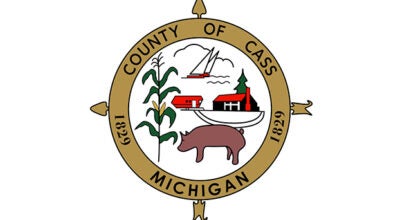Mixed oak savanna a transitional habitat
Published 6:36 pm Sunday, May 2, 2010

Girl Scouts watch as Grounds Director Matt Stack demonstrates the proper way to plant a tree. (The Daily News/John Eby)
By JOHN EBY
Dowagiac Daily News
Some of Dowagiac’s natural history speaks to trees. Some doesn’t.
“What struck me as very interesting,” Arbor Day keynote speaker Geoffrey Cripe said, “was when I looked at pre-settlement maps from the early 1800s. This whole area was mixed oak savanna.”
Mixed oak savanna “is a transitional habitat type between the broadleaf deciduous forests on our East Coast and the open Great Plains to the west.
“It’s primarily Indian grass, big blue-stemmed grass and scattered oaks that make up this habitat type,” Cripe said.
“They were kept oak by our Native ancestors who burned them to keep them open for grazing bison, antelope and deer for a food source.
“When settlers moved in and put a railroad in,” he continued, “there were actually some accidental fires that helped keep this area open.
“I learned it was from when they were stoking the train engines with coal and wood, it would spark and ignite accidental fires that kept a lot of this area open into the 1900s.”
More recently, when the Clinton administration recognized the Dowagiac-based Pokagon Band of Potawatomi Indians, they acquired land where black ash grew which could be used in baskets they make.
Since “Mother Nature always wins,” it’s “always best if we work with Mother than against Mother,” Cripe, a land protection specialist for the Southwest Michigan Land Conservancy in Portage, said Friday at Dowagiac’s fourth annual Arbor Day celebration on the City Hall lawn.
“We’re all part of one system,” Cripe said. “Just like the organs in our body, we all serve a function and depend on one another and all living things to survive. Trees themselves have endless contributions to this world. They act as windbreaks, keeping our soil in place. They absorb carbon from the atmosphere, where we produce carbon in excess.
They provide us with shade. They help us moderate temperatures. They lessen the impact of severe storms. They can also help us reduce our energy dependence. I’ve talked to several farmers who have planted a shelter belt of trees, pine and deciduous, on the north and west sides of their houses, which keeps their places cool in the summertime and insulated from snow in the wintertime, bringing down the utility bill.”
Cripe said trees are also a resource for fuel and building materials.
“In this state we have a wealth of resources,” he said. “There are plenty of ways to selectively harvest where you can improve the quality of the forest rather than damage them. Trees have an enormous capacity to moderate flooding and fluctuations in our lakes, rivers and streams as they respond to rainfall events. They provide habitat for literally thousands of species. That’s the tip of the iceberg.”
Cripe recalled that a former Detroiter, J. Sterling Morton, started Arbor Day in Nebraska in 1872.
“To me,” Cripe said, “Arbor Day is an opportunity to understand and appreciate the many contributions our trees make toward improving the quality of our lives and the lives of all the critters, birds and insects that make this an interesting place to live here on Earth.”
“I’m very thankful to Ed Darr for recognizing the significance of this holiday and coordinating this event for Dowagiac,” Cripe concluded.
Dowagiac Arbor Day Committee Chairman Dan Williams of Williams A-1 Expert Tree Service observed a moment of silence for Edwin R. Darr, who died March 7 at 82.
Jessica Poulsen, Michigan State University Extension 4-H youth educator, introduced 4-Hers Abbie Harris and Cara Hodges.
“I just want to emphasize the good work our youth are doing,” she said.
Hodges serves on the Michigan Youth Conservation Council and is working all over the state on windmill projects.
Abbie, 13, of Edwardsburg, belongs to the Flaming Youth 4-H club and was one of Michigan’s 2009 Big Tree contest winners last September in Midland with a huge sugar maple by her grandparents’ which measured 18 feet around.
“I’m the youngest steward ever for the Michigan Nature Association,” which preserved Dowagiac Woods.
“I take care of the Radebaugh Nature Preserve in Edwardsburg,” said Abbie, who was also a 2009 winner of the Young Naturalist Award from New York City.
“There are lots of ways kids can help out with conservation,” Abbie said. “They can plant trees, clean up trash, recycle and make other people aware.”
Dowagiac’s state Rep. Sharon Tyler, R-Niles, said, “Between Earth Day and Arbor Day, I’ve planted over 60 trees and 300 bulbs. I hope everybody’s out planting trees today. Join with me in that planting.”
Tyler said, “Our environment is important and, without trees, I think we can all agree it would be less enjoyable to walk around our beautiful city of Dowagiac. Arbor Day is celebrated in all 50 states. There are 119 cities in Michigan which have received Tree City USA designations. Dowagiac is one of only two cities in southwest Michigan.
“Ed Darr was instrumental in helping Dowagiac receive the Tree City USA designation. Thanks to Ed, Dowagiac has become an even more beautiful place to live and work. His memory will stay alive as well at every Dowagiac Arbor Day celebration and every stroll downtown.
“On Arbor Day we all have an important job to remember. We are reminded of the importance of planting trees. It may seem like a simple act, but trees give us clean air to breathe and make life possible. While we only have one official Arbor Day, we should all strive to plant trees and to maintain our trees throughout the year, helping to keep our homes clean and pleasant for everyone to enjoy. Thank you for allowing me to be here.”






